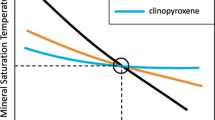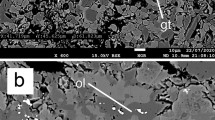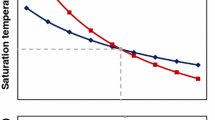Abstract
The crystal structures of 212 experimentally synthesized, igneous clinopyroxenes were modeled from electronprobe chemical data. The coexisting melts span a wide range of petrologically relevant, dry and hydrous compositions, characterized by variable enrichment in silica and alkalis. Experimental conditions pertain to Earth's crust and uppermost mantle (P = 0–24 kbar; garnet absent) and a variety of f O2 values (from CCO-buffered to air-buffered) and mineral assemblages (Cpx ± Opx ± Pig ± Ol ± Plag ± Spl ± Mt ± Amp ± Ilm). Unit-cell volume (Vcell) versus M1-polyhedron volume (VM1) relations were investigated over a range of pressures and temperatures using data derived from structure modeling and corrected for thermal expansivity and compressibility. The relationships between pressure and clinopyroxene structural parameters were found to be dependent on the nature of the coexisting melt. To reduce compositional effects, only clinopyroxenes belonging to mildly alkaline (MA) and tholeiitic (TH) series were considered. Pressure was modeled as a linear function of Vcell, VM1, and Mg/(Mg + Fe2+)Cpx ratio. A calibration based on the whole data set (MA+ TH) reproduced the experimental pressures within 1.4 kbar at the 1-σ level. The maximum residuals were 3.5 kbar and 3.9 kbar for MA- and TH-clinopyroxenes, respectively. Better statistics were obtained by considering MA- and TH-clinopyroxenes separately. A calibration based on the 69 MA-clinopyroxenes reproduced the experimental pressures within 1.1 kbar (1σ) and with a maximum residual of 2.7 kbar. A calibration based on the 143 TH-clinopyroxenes reproduced the experimental pressures within 1.0 kbar (1σ) and with a maximum residual of 3.4 kbar. When these geobarometers are applied to natural samples for which P is unknown, the correction for compressibility is necessarily made through a trial-and-error procedure. This expedient propagates an additional error that increases the above uncertainties and residuals by a factor of about 2. Applications to natural, igneous rocks for which the pressures of crystallization could be constrained based on experimental, petrological or geological evidence yielded pressure estimates that reproduced the expected values to within ca. 2 kbar. Compared to the MA-formulation, the TH-formulation appears to be less robust to variations in magma composition. When applied to high-pressure (>10 kbar) clinopyroxenes synthesized from very low Na (Na2O < 1.5%) melts, the latter geobarometer can underestimate P by as much as 6 kbar. Calculation of P through the present geobarometers requires clinopyroxene major-element composition and an independent, accurate estimate of crystallization T. Underestimating T by 20 °C propagates into a 1-kbar increase in calculated P. The proposed geobarometers are incorporated in the CpxBar software program, which is designed to retrieve the pressure of crystallization from a clinopyroxene chemical analysis.
Similar content being viewed by others
Author information
Authors and Affiliations
Additional information
Received: 11 June 1998 / Accepted: 12 November 1998
Rights and permissions
About this article
Cite this article
Nimis, P. Clinopyroxene geobarometry of magmatic rocks. Part 2. Structural geobarometers for basic to acid, tholeiitic and mildly alkaline magmatic systems. Contrib Mineral Petrol 135, 62–74 (1999). https://doi.org/10.1007/s004100050498
Published:
Issue Date:
DOI: https://doi.org/10.1007/s004100050498




